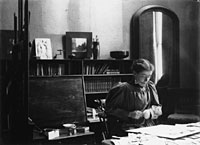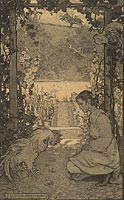
Elizabeth Shippen Green's Working Methods
Elizabeth Shippen Green trained at the Pennsylvania Academy of the Fine Arts, studied with Howard Pyle, and lived for much of her adult life with fellow illustrators Jessie Willcox Smith and Violet Oakley. Although all of these influences are evident in her work, Green nevertheless developed a unique artistic persona. She achieved this through the variety of media and styles she employed, and through the highly organized system of references she used in creating her compositions. Over the course of her career, Green became accomplished in a much wider variety of media than most illustrators, choosing from her technical repertoire the most effective vehicle for her current assignment. She began her career working in pen and ink, which was common for the newspaper and fashion work she did in the 1890s. Over the years she frequently returned to this medium, as she did for the wonderfully complete Welcome, said the old man: will you come with us, finished in 1910. More often by the turn of the century, she worked in charcoal, the medium favored at the Pennsylvania Academy, and most common to the women artists of the day. It was with charcoal that Green developed the bold outlining and delicate shading that were so effective for the grisaille halftones being published at the time. Between 1900 and 1910 as publishers began to demand color, Green developed a mixed media technique similar to that used by her colleague Jessie Willcox Smith. In these drawings she began with charcoal, then applied fixative to the underdrawing before adding watercolor or oil paint. To bring out certain details, more charcoal might then be added over another layer of fixative. These drawings could be done more quickly than oil painting, enabling the artists to meet the stringent deadlines in their heavy workloads. The resulting works, translucent with the heavy outlines and richly glowing colors, often resembled stained glass--a medium for which Green's other colleague Violet Oakley was famous. But when she worked with oil paint, as in the Pyle-like Once more the herald set the trumpet to his lips and blew, Green proved equal to that task as well. In addition to the variety of media she used, Green also differed from most of her contemporaries in the highly organized system of references she used for her paintings. As the "librarian" for the Red Rose Girls, she kept a large cabinet neatly filled with portfolios of photographs and clippings that could be used as visual aids in compositions. Although most other illustrators still worked directly from costumed models, Green found this practice both expensive and time-consuming. Because she had learned about photography while at the Pennsylvania Academy, she found it more efficient and economical to photograph friends or workers in poses or costumes related to her current project. Although some of the photographs Green took involved figures in simple poses and settings that could be used for general reference, most were composed for a specific illustration. Her drawing of the little girl in Won't you eat just one more kernal (sic), Thomas Jefferson? closely resembles the accompanying photograph in every detail, from the folds in the dress to the style of the hair to the reflection on the shoe. The model for "Thomas Jefferson" would have come from the extensive clipping file, which contained every conceivable image, even farm animals. Finally the composition was set in a landscape drawn from the grounds at the Red Rose Inn.
Green's use of photographs to compose and inform her drawings was advanced--most illustrators did not make common use of photography till many years later. By wisely using the many resources available to her--photography, clipping files, above all, her training and facility in many different media--Elizabeth Shippen Green developed a complex method of drawing that enabled her to produce a wonderfully varied body of work during a long and fruitful career. --Richard Kelly Richard Kelly, founder of the Kelly Collection of American Illustration, has worked extensively with collections of graphic art in the Library's Prints and Photographs Division. Comments on the Exhibition: swann@loc.gov Contact Us ( February 11, 2008 ) |


